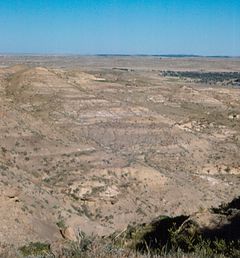| Lance Formation | |
|---|---|
| Stratigraphic range: Maastrichtian ~ | |
 Badlands in the Lance Formation along Cow Creek near the type locality, Niobrara County, Wyoming | |
| Type | Sedimentary |
| Underlies | Fort Union Formation |
| Overlies | Meeteetse Formation |
| Thickness | up to 600 metres (1,970 ft) |
| Lithology | |
| Primary | Sandstone, siltstone, shale |
| Location | |
| Region | Wyoming |
| Country | United States |
| Type section | |
| Named for | Lance Creek, Wyoming |

The Lance (Creek) Formation is a division of Late Cretaceous (dating to about 69–66 Ma) rocks in the western United States. Named after Lance Creek, Wyoming, the microvertebrate fossils and dinosaurs represent important components of the latest Mesozoic vertebrate faunas. The Lance Formation is Late Maastrichtian in age (Lancian land mammal age), and shares much fauna with the Hell Creek Formation of Montana and North Dakota, the Frenchman Formation of southwest Saskatchewan, and the lower part of the Scollard Formation of Alberta.
The Lance Formation occurs above the Baculites clinolobatus ammonite marine zone in Wyoming, the top of which has been dated to about 69 million years ago, and extends to the K-Pg boundary, 66 million years ago. However, the characteristic land vertebrate fauna of the Lancian age (which take its name from this formation) is only found in the upper strata of the Lance, roughly corresponding to the thinner equivalent formations such as the Hell Creek Formation, the base of which has been estimated at 66.8 million years old.[1]
- ^ Lehman, T. M., Mcdowell, F. W., & Connelly, J. N. (2006). First isotopic (U-Pb) age for the Late Cretaceous Alamosaurus vertebrate fauna of West Texas, and its significance as a link between two faunal provinces. Journal of Vertebrate Paleontology, 26(4), 922–928.